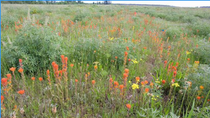

BioBlitz at Rasor Park with Rick Ahrens
BioBlitz at Rasor Park with guides Rick Ahrens, Becky Riley, James Hershiser Sunday, April 28, 1-5 PM 1-2 PM Trees, Shrubs, Wildflowers...


Monarchs and Milkweed
(9:30 minute video) Monarch butterfly populations have declined 90 percent across the US. A key piece of their habitat has been wiped out by farms and urban sprawl. Milkweed is the single most important plant for monarchs. It’s the only one they lay their eggs on and young caterpillars eat. People are encouraged to plant milkweed wherever they can to help monarchs along their long migration routes. [IMPORTANT: Plant only milkweed that is native to your area. In Oregon's Willa
City of Eugene Native Plant Alternatives
(6 page PDF document) Native Plant Alternatives. There are many beautiful native species that are readily available from local native plant nurseries. Below is a list of some of the more common species that are found in the southern Willamette Valley. While native species generally require less water and care than non-native species, this is only true when planted in the appropriate soil moisture and sunlight conditions. We have tried to include brief notes on habitat requir
Western Oregon Prairies
(2 page brochure) What are prairies?; Animals and plants of upland prairies; Are prairies in trouble?; How can you help? Native prairies are a severely endangered habitat in Western Oregon... Oregon State University and US Fish and Wildlife Service. Western Oregon Prairies
What's So Special About Oregon White Oaks?
What's So Special About Oregon White Oaks? It’s now estimated that more than 99 percent of pre-settlement prairies and savannas in Oregon have been converted to urban areas, farms, and other developments. In addition to urban development, yet another challenge to this native tree is the spread of invasive plant species. Diversity of bird species is often higher in oak forests than in adjacent conifer forests. Oregon white oaks provide favorable habitat to a number of importa


Native Herbaceous Plants in Our Gardens: A Guide for the Willamette Valley
(40-page booklet) Excerpts from Native Herbaceous Plants In Our Gardens: "Growing native herbaceous plants in our gardens may preserve or re-introduce many of the diverse plants that weave natural tapestries across the Willamette Valley. Herbaceous plants are annuals and perennials that lack woody stems; they include bulbs, grasses, sedges, rushes, evergreen and deciduous ferns, and broad-leaved flowering plants. Historically, these native plants thrived in the Willamette V






















